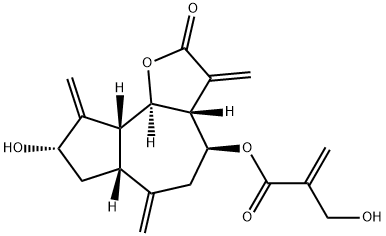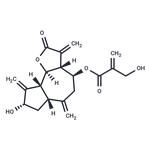Uses
Cynaropicrin can inhibit lipopolysaccharide-induced TNF-α release from either murine or human macrophage cells in a dose-dependent manner with the IC50 values of 8.24 and 3.18 μM, respectively. It can also inhibit the increase of cartilage degradation factor (MMP13) and suppresses NF-κB signaling.
Biological Activity
Cynaropicrin is a potent activator of the AhR-Nrf2-Nqo1 pathway, making it a potential candidate for preventing UVB-induced photoaging. Additionally, it exhibits pro-apoptotic activity, suggesting its potential as an anticancer agent against certain leukocyte cancer cells such as lymphoma or leukemia. Cynaropicrin has demonstrated in vivo activity against Trypanosoma brucei and exhibits immunomodulatory effects by influencing cytokine release and nitric oxide production while also displaying immunosuppressive properties. Moreover, it has anti-inflammatory effects by inhibiting the production of inflammatory mediators and lymphocyte proliferation, which is achieved through conjugation with sulphydryl groups of target protein(s).



